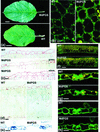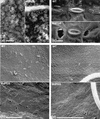Overexpression of polygalacturonase in transgenic apple trees leads to a range of novel phenotypes involving changes in cell adhesion
- PMID: 12011344
- PMCID: PMC155877
- DOI: 10.1104/pp.010986
Overexpression of polygalacturonase in transgenic apple trees leads to a range of novel phenotypes involving changes in cell adhesion
Abstract
Polygalacturonases (PGs) cleave runs of unesterified GalUA that form homogalacturonan regions along the backbone of pectin. Homogalacturonan-rich pectin is commonly found in the middle lamella region of the wall where two adjacent cells abut and its integrity is important for cell adhesion. Transgenic apple (Malus domestica Borkh. cv Royal Gala) trees were produced that contained additional copies of a fruit-specific apple PG gene under a constitutive promoter. In contrast to previous studies in transgenic tobacco (Nicotiana tabacum) where PG overexpression had no effect on the plant (K.W. Osteryoung, K. Toenjes, B. Hall, V. Winkler, A.B. Bennett [1990] Plant Cell 2: 1239-1248), PG overexpression in transgenic apple led to a range of novel phenotypes. These phenotypes included silvery colored leaves and premature leaf shedding due to reduced cell adhesion in leaf abscission zones. Mature leaves had malformed and malfunctioning stomata that perturbed water relations and contributed to a brittle leaf phenotype. Chemical and ultrastructural analyses were used to relate the phenotypic changes to pectin changes in the leaf cell walls. The modification of apple trees by a single PG gene has offered a new and unexpected perspective on the role of pectin and cell wall adhesion in leaf morphology and stomatal development.
Figures




Similar articles
-
Down-regulation of POLYGALACTURONASE1 alters firmness, tensile strength and water loss in apple (Malus x domestica) fruit.BMC Plant Biol. 2012 Aug 2;12:129. doi: 10.1186/1471-2229-12-129. BMC Plant Biol. 2012. PMID: 22856470 Free PMC article.
-
Insights into the effects of polygalacturonase FaPG1 gene silencing on pectin matrix disassembly, enhanced tissue integrity, and firmness in ripe strawberry fruits.J Exp Bot. 2013 Sep;64(12):3803-15. doi: 10.1093/jxb/ert210. Epub 2013 Jul 19. J Exp Bot. 2013. PMID: 23873994 Free PMC article.
-
Analysis of tomato polygalacturonase expression in transgenic tobacco.Plant Cell. 1990 Dec;2(12):1239-48. doi: 10.1105/tpc.2.12.1239. Plant Cell. 1990. PMID: 2152163 Free PMC article.
-
Fruit softening and pectin disassembly: an overview of nanostructural pectin modifications assessed by atomic force microscopy.Ann Bot. 2014 Oct;114(6):1375-83. doi: 10.1093/aob/mcu149. Epub 2014 Jul 25. Ann Bot. 2014. PMID: 25063934 Free PMC article. Review.
-
Pectin: cell biology and prospects for functional analysis.Plant Mol Biol. 2001 Sep;47(1-2):9-27. Plant Mol Biol. 2001. PMID: 11554482 Review.
Cited by
-
Identification of Candidate Genes Involved in Fruit Ripening and Crispness Retention Through Transcriptome Analyses of a 'Honeycrisp' Population.Plants (Basel). 2020 Oct 10;9(10):1335. doi: 10.3390/plants9101335. Plants (Basel). 2020. PMID: 33050481 Free PMC article.
-
Metabolism of Stone Fruits: Reciprocal Contribution Between Primary Metabolism and Cell Wall.Front Plant Sci. 2020 Jul 9;11:1054. doi: 10.3389/fpls.2020.01054. eCollection 2020. Front Plant Sci. 2020. PMID: 32733527 Free PMC article. Review.
-
Genome-Wide Identification and Expression Profiling of the Polygalacturonase (PG) and Pectin Methylesterase (PME) Genes in Grapevine (Vitis vinifera L.).Int J Mol Sci. 2019 Jun 28;20(13):3180. doi: 10.3390/ijms20133180. Int J Mol Sci. 2019. PMID: 31261768 Free PMC article.
-
Mutation of the Polygalacturonase Gene AcoPG3 Deferred Softening of Pineapple Fruit.Biology (Basel). 2025 Apr 25;14(5):474. doi: 10.3390/biology14050474. Biology (Basel). 2025. PMID: 40427662 Free PMC article.
-
Immunolocalization of pectic polysaccharides during abscission in pea seeds (Pisum sativum L.) and in abscission less def pea mutant seeds.BMC Res Notes. 2016 Aug 31;9(1):427. doi: 10.1186/s13104-016-2231-z. BMC Res Notes. 2016. PMID: 27581466 Free PMC article.
References
-
- Ahmed AER, Labavitch JM. A simplified method for accurate determination of cell wall uronide content. J Food Biochem. 1977;1:361–365.
-
- Albersheim P, Nevins DJ, English PD, Karr A. A method for the analysis of sugars in plant cell-wall polysaccharides by gas-liquid chromatography. Carbohydr Res. 1967;5:340–345.
-
- ASTM. ASTM Standards on Color and Appearance Measurement. Ed 5. West Conshohocken, PA: ASTM; 1996.
-
- Atkinson RG, Bolitho KM, Wright MA, Iturriagagoitia-Bueno T, Reid SJ, Ross GS. Apple ACC-oxidase and polygalacturonase: ripening-specific gene expression and promoter analysis in transgenic tomato. Plant Mol Biol. 1998;38:449–460. - PubMed
Publication types
MeSH terms
Substances
LinkOut - more resources
Full Text Sources
Other Literature Sources

